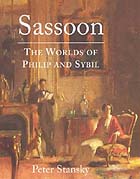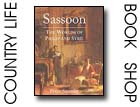Sassoon: The Worlds of Philip and Sybil
The latest research on the exotic Sassoon siblings fascinates Clive Aslet


Philip and Sybil Sassoon were different from other people. Not only were they always rich, their parents having died relatively young, but they were also Jewish. It was generally assumed that Philip, with his exotic tastes, was homosexual: Peter Stansky scrupulously writes that he has found nothing to support or deny the claim, but that is probably because Sybil destroyed her brother's intimate papers before she died. Frances Stevenson, Lloyd George's mistress, called him 'as clever as a cartload of monkeys'. Sybil's intelligence, as well as the cultural depth that made her a legendary chatelaine of Houghton, must have seemed daunting at a time when women's education was second rate. Society's response to such a remarkable brace of siblings is the recurrent theme of this book.
Who could not find it fascinating? They were brought up to know all the best people, including the Prime Minister, Arthur Balfour: the chair in which he died was a present from Philip.
In a terrible two years, Philip and Sybil lost grandmother, grandfather, mother, then father -'J'etais tout le temps en deuil,' Sybil recalled later, in her effortless French. This left Philip, at 23, in possession of an enormous house in Park Lane, so big that he later used it for art exhibitions, as well as Trent Park, outside London. In addition, he felt the need for Herbert Baker, a surprisingly stuffy choice, to build Port Lympne, near Hythe: it was in his father's old constituency, now represented by Philip as the youngest MP in the House.
Philip had the house decorated in the Ballet Russe style, with very unstuffy murals by Jose Maria Sert, with, as the Prime Minister Asquith puts it, 'elephants in different attitudes'.
'Personally, I think it monstrous,' wrote Philip with studied nonchalance. Later the murals were painted over and the gardens laid out by the more suitable Philip Tilden, in the Ben Hur style.
Throughout the First World War, Philip served as Douglas Haig's private secretary, which introduced him to all the leading political figures in Europe. Taking a staff job did not increase his popularity with families who had lost sons at the Front, but he fulfilled it brilliantly - one of his responsibilities being, in modern parlance, to spin the losses on the Western Front to the press.
After the war, he became minister for the fledgling Royal Air Force, one of whose duties was, as it happens, to police Iraq. The author does not raise an eyebrow at the crowds of young airmen flocking to meet Philip's grand friends at Port Lympne; others did.
Exquisite houses, the beauty of Nature, and how to get the most from your life, straight to your inbox.
The Thirties were devoted to collection, with perfect but conventional taste, and making Trent Park (refaced with old bricks from the demolished Devonshire House) exquisite. With 'darlingest' Philip's death in 1939, Sybil is left alone on the stage. Except that, as Marchioness of Cholmondeley, she was far from alone.
As Stansky observes, she was closer to the heart of British life than her brother, who seems to have had few close relationships outside the Sassoon family. The British upper class was not, for the most part, openly anti-Semitic; but the most frequently used adjective used in connection with Philip was 'oriental'. Everyone knew what it meant.Order Sassoon: The Worlds of Philip and Sybiltoday
Return tobook reviews


Country Life is unlike any other magazine: the only glossy weekly on the newsstand and the only magazine that has been guest-edited by His Majesty The King not once, but twice. It is a celebration of modern rural life and all its diverse joys and pleasures — that was first published in Queen Victoria's Diamond Jubilee year. Our eclectic mixture of witty and informative content — from the most up-to-date property news and commentary and a coveted glimpse inside some of the UK's best houses and gardens, to gardening, the arts and interior design, written by experts in their field — still cannot be found in print or online, anywhere else.
-
 McLaren Special Operations — The secret Surrey skunkworks producing Britain's most bespoke supercars
McLaren Special Operations — The secret Surrey skunkworks producing Britain's most bespoke supercarsThere's owning a McLaren and then there's owning an MSO McLaren. James Fisher finds out what makes the bespoke division of Britain's premier supercar manufacturer so special.
-
 18 country houses across Britain, from £400,000 to £4 million, as seen in Country Life
18 country houses across Britain, from £400,000 to £4 million, as seen in Country LifeOur look at the homes to come to the market via Country Life this week picks out a charming Kent cottage and an Arts and Crafts house in Leicestershire.
